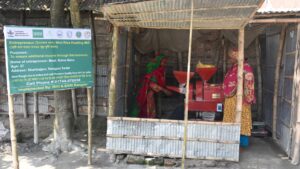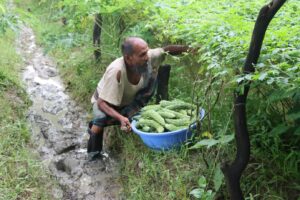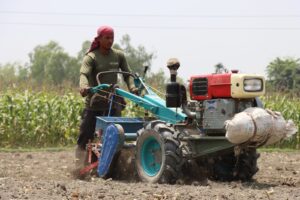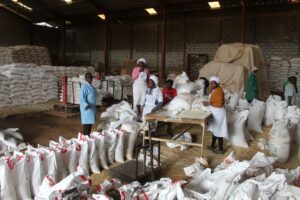by Kofi Britwuma and Matty Demont
Although several initiatives to reduce food production deficits and increase net food supply have yielded positive outcomes, it has been argued that food availability in itself is only one metric within the food security puzzle, and may not be sufficient to turn the tide towards achieving zero hunger. Food cultural heritage and social values are key in driving changes in sustainable agricultural systems, although these have tended to be overlooked. To enhance food security efforts, it is imperative policy is aligned to or leverages food-related cultural heritage.
Although several initiatives to reduce food production deficits and increase net food supply have yielded positive outcomes, it has been argued that food availability in itself is only one metric within the food security puzzle, and may not be sufficient to turn the tide towards achieving zero hunger.
Others have suggested supply chain improvements to harmonize synergies between smallholder producers and suppliers on the one hand, and smallholder producers and consumers on the other. Specific to supply chain bottlenecks that have been escalated by the COVID-19 pandemic, improving transportation infrastructure and reforming trade and taxation policies can facilitate the movement of especially perishable produce from production centers to consumers. Additionally, leveraging technology and advances in communication can help bridge the informational gap between food suppliers and buyers.
As the world transitions into a “post-pandemic” era, a focus on sustainability and resilience is vital to building a more robust food system that can withstand future shocks, such as climate shocks. Among others, this will require approaches such as a reduction in food waste and an emphasis on food valorization.
While these arguments are no doubt compelling, food systems are enmeshed in culture and tradition. Across many agrarian communities, food production and processing practices and preferences for “authentic” food attributes tend to bear the hallmarks of tradition passed along successive generations. As such, to enhance food security efforts, it is imperative policy is aligned to or leverages food-related cultural heritage. Food cultural heritage and social values are key in driving changes in sustainable agricultural systems, although these have tended to be overlooked.
Cultural heritage embodies indigenous culture, values, and traditions inherited from previous generations. For areas that boast rich cultural heritage, its influence permeates the types of food and how they are produced, value addition, processing, and indigenous preferences for them. For example, the relationship between food identity and a people’s cultural idiosyncrasies, with documented evidence of such relationships observed across the type of food consumed, mode of consumption, when it is consumed, and with whom it is shared.
Strong overlaps have also been reported between heritage food and cultural identity, with this relationship dimensioned within the scope of legacy, people, and place.
According to UNESCO, cultural heritage can be considered tangible, such as paintings and archeological sites, or intangible, such as the arts, traditions, and rituals. Agriculture and food embody aspects of both tangible and intangible cultural heritage, although discussions about food and cultural heritage in the same breath have been relatively nascent. In addition to the inadequate recognition of tangible and intangible aspects of the culture that surrounds local foods, there has been a general lack of inclusion of key stakeholders in the food heritagization processes.
In fact, food was first recognized by UNESCO as an intangible cultural heritage as recently as 2010, featuring the Mediterranean diet, Mexican cuisine, French Gastronomic meal, and Croatian gingerbread. Also noteworthy, framing food within a cultural heritage sphere has wider implications beyond just a cultural identifier.
Indeed, food systems are embedded in economic systems which ultimately forge both community and economic identities. The observation about shifting paradigms between tangible and intangible cultural heritage, intangible aspects of heritage were being morphed into tangible components, with notable evidence in novel “heritage food” products and opportunities for agritourism.
Tangible aspects of cultural heritage had trappings of the intangible, such as having pastures or terraces that provide shared cultural and traditional identities. Cuisines ascribe a unique heritage value to people groups in specific geographies, from their preparation to consumption. It was noted further that food could serve as a differentiating entity in an increasingly global landscape, leading to the development of a heritage-based identity and a potential touristic attraction.
From the foregoing, it is apparent that identities are established through cultural heritage. Despite this, cultural identities can and do evolve, and with time, food, and commodities not originally native to an area could be adapted to become part of their identity.
A case in point is the cocoa crop, which while native to the Aztecs and Mayans people of South America, has shaped the identities of parts of West Africa since its introduction into these areas in the 19th century. Other examples include tomatoes, which although originating in western South America has become a fixture in Mediterranean cuisines, or the case of maize which, although originating from central Mexico, has become a staple across a wide swath of sub-Saharan Africa.
Apart from food commodities becoming indigenized and coopted into food cultures in regions other than their native origins, there is evidence showing that indigenous technologies are passed down along successive generations. Early Portuguese colonialists to the Upper Guinea Coast in the 16th century, for example, observed a rather sophisticated indigenous rice production system, including the construction of dikes to retain swampy conditions and transplanting of the sprouted crop on less swampy grounds.
The fact that the Jola people of Senegal’s Casamance Region and Guinea-Bissau and Guinea Conakry used similar techniques to grow rice as recently as the 1960s is a testament to the enduring strength of cultural heritage across generations in these areas.
From these discussions, it can be understood that diverse aspects of food production and consumption identities have been, and are shaped by cultural heritage. Not well understood, however, is the nexus between cultural heritage and the “farm to fork” production, supply, and demand cycles, and how leveraging an understanding of this relationship can enhance food security.
Incidentally, the literature has been relatively mute about how cultural heritage can be leveraged to enhance and strengthen food security across the Global South.
Previous efforts have largely examined cultural heritage within specific contexts such as sustainable ecological systems, agritourism, commodification and valorization, diets, and food preferences. We address this gap by exploring how cultural heritage interacts with food systems and how it can be harnessed to address food insecurity in the Global South.
This topic is vast, and the goal of this effort is not to exhaust the plethora of pathways between cultural heritage and food security. Rather, given the broad scope, we delimit the breadth of our review to the world’s major staple cereal crops, i.e., rice, wheat, and maize, and largely focus on rice, as it has emerged as the de facto staple of the Global South.
Secondly, we delimit the depth of our review to five essential aspects through which policymakers can harness cultural heritage to strengthen food systems and food security:
(i) preservation of genetic resources,
(ii) valorization,
(iii) traditional food processing,
(iv) preference matching, and
(v) agritourism.
Enhancing physical, social, and economic access to safe and nutritious food cannot be achieved without increasing food availability and improving supply chains. However, the fact that significant pockets of food insecurity exist in the Global South, despite the exponential increase in available food globally in recent decades, suggests that more needs to be done beyond these efforts. This review explores five pathways through which cultural heritage can be harnessed to enhance food security.
Preservation methods such as ex situ conservation and gene banks have played a crucial role in saving germplasm that might otherwise have eroded away. The renewed focus on in situ biodiversity can inform breeding priorities in favor of varieties native to particular locales and embedded in rich cultural heritage.
The example of Laos can serve as a model for food policy across regions with food cultural heritage. The country has emerged as a hub for rice biodiversity as a result of the synergies between rice cultural heritage and germplasm conservation.
Having a rich rice cultural heritage that encouraged seed sharing across ethnicities, and thanks to the establishment of an international gene bank that complemented preservation efforts fostered by cultural heritage, Laos has managed to preserve thousands of rice varieties.
We thus argue that a phased introduction of preserved germplasm back in jurisdictions that boast rich cultural heritage can engender farmer participation, improve genetic biodiversity, and ultimately food security. Such an initiative, however, would need to be matched with investments in the improvement of soil quality, water availability, and expanded market access.
In situ conservation of genetic resources may require valorization to generate the necessary market incentives for farmers to preserve cultural heritage. Policymakers and value chain actors can consider place branding, geographic indicators, product differentiation, promotion of dietary shifts, information provision, and staging of experiences to encourage consumer involvement in the preservation of cultural heritage.
Moreover, as lessons from new and emerging urban areas in developing regions have shown, the finish of food is as important as its availability. As such, food valorization through the value chain that incorporates culturally preferred finish and strives to meet consumers’ growing expectations of authentic quality can drive local demand, fetch price premiums for farmers, encourage continued cultivation, and forge economic resilience.
This would demand supporting investment in traditional food processing technologies that are able to preserve the authentic product finish that connects consumers to cultural heritage and involves them in preserving the latter. In historical centers of rice domestication, in particular, food policymakers can leverage the rich cultural heritage in these areas by supporting private sector investment in traditional processing.
Other realms of intangible cultural heritage including the nature of production systems passed along multiple generations have become attraction points for tourists, creating a micro-economy in such regions with positive impacts on incomes and food security.
In particular, rice terraces in parts of Southeast Asia with rich cultural heritage have become identity markers for natives who live in these regions and have generated considerable agritourism in these areas. The increased purchasing power from the “tourism economy” can improve the economic resilience of indigenous communities and lead to enhanced food security.
Policymakers may, however, face complex trade-offs, e.g., in instances where traditional varieties, farming, and processing methods embedded in cultural heritage result in low productivity, but where the introduction of new varieties, cultivation practices, or modern processing attenuates the authenticity of cultural heritage associated with the rice terraces. Policies geared towards agricultural productivity in these regions should thus be cognizant of these trade-offs and navigate a balance between food availability and the traditions that define such areas.
Finally, it is important to recognize that, cultural heritage, to the extent it builds unhealthy pockets of resistance to more efficient production processes, product quality upgrading, food safety, or healthier diets, could be inimical to food security efforts. This presents another area where policymakers might be conflicted between the preservation of cultural heritage versus the introduction of more efficient production methods or nutritional changes.
Rather than disregard or discount the influence of cultural heritage in such instances, nutritionists and policymakers can harness it to improve dietary and food security programs. This will require close collaboration with important custodians of cultural heritage, such as traditional food processors and restaurants, chefs, gastronomy and food scientists, and the tourism industry.
Similarly, certain traditional crop varieties may have lower productivity and present a similar “cultural heritage versus high productivity” conundrum.
Although policymakers face the complex task of balancing these trade-offs, they can leverage cultural heritage to enhance food security by supporting the preservation of genetic resources, valorization, traditional food processing,
preference matching, and agritourism.
This review is largely exploratory in its attempt at illuminating the role of cultural heritage in food security; further discussions between food security and anthropological constructs are warranted to lend additional insights into this all-important but vast topic.
Read the study:
Britwum k and Demont M. (2022) Food security and the cultural heritage missing link. Global Food Security,
Volume 35.






